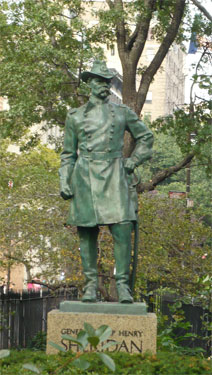 Two hundred years before that, the area had been a Dutch tobacco farm, so there's smoke all over Christopher Park's history, and this guy is celebrating that fact.
Two hundred years before that, the area had been a Dutch tobacco farm, so there's smoke all over Christopher Park's history, and this guy is celebrating that fact.Today many of the park's regulars are black...

Yet Christopher Park is also home to the whitest people in New York City: the two frozen couples who make up George Segal's snow-white-painted bronze sculpture, Gay Liberation. Being a stone's throw from the Stonewall Inn, epicenter of the gay liberation movement, the park is an appropriate site for the monument.

There's more bronze in the park's eastern tip in the form of a statue of Philip Sheridan, the Civil War general.
 Why he's here, and not in some other park, I have no idea. But as seen here, glorified, he looks a good deal more like the heroic Civil War leader than the man later accused of genocide for his attempts to "pacify" the Indians of the Great Plains after the Civil War.
Why he's here, and not in some other park, I have no idea. But as seen here, glorified, he looks a good deal more like the heroic Civil War leader than the man later accused of genocide for his attempts to "pacify" the Indians of the Great Plains after the Civil War.The park was last spruced up in the 1980s, and it shows some signs of wear and tear—nothing too specific, just an overall scruffy quality, especially in comparison with the lush neatness—if that's not a contradiction in terms—of some nearby parks like newly spiffed-up Washington Square and the bucolic Jefferson Market Garden. In Christopher Park you don't feel like you've left the city; its narrowness and scruffiness feel very urban. But those same qualities have their value, too, indicating, for one thing, the great age of the park, and the history, from farm to fire to social conflagration, that coats it like an invisible dusting of pollen. (There's real pollen, too, believe me.)
Even the flaking iron fence is old—130 years old, according to the Parks Department. You can see it in the foreground of the first large photo above.
No comments:
Post a Comment